As preppers, we’re all used to rotating our food supplies. When you come home from the store with five cans of soup they go to the back of the shelf, and when you decide you want soup for dinner you take a can from the front.
That keeps your food supplies as new as possible, and you should do the same with your ammunition. New bullets in, old bullets out.
What if you slip up, though? If you’re running low on ammo, and all that’s left on the shelf is a faded box of rounds you picked up when Reagan was in the White House, what should you do? Is that old ammunition still going to work – and is it even safe to try?
Factory Loads Only?
First, what kind of ammunition is it? If you have old factory-loaded ammo, hold on to it.
If you have old handloads that you didn’t load yourself, get rid of it.
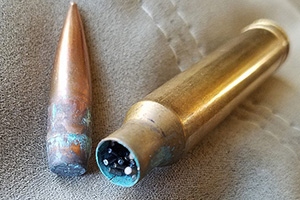
You don’t know how accurately it was charged, and firing it risks damage to your guns or even injury to you.
If you’re a reloader you can break it down and reuse the cases and bullets, otherwise take it to your local range or police for safe disposal.
It’s just not worth the risk.
Related: Top 13 Survival Uses For Fired Ammo
On the other hand, if you have commercial ammunition you can be pretty confident every round has the right charge in it and should be safe to fire. Ammunition isn’t like food; the chemicals in it will degrade over time – everything does – but very slowly.
Ammunition that’s years, even decades, old could work as well as the day it was made.
What About Corrosive Primers?
Many shooters are worried about the primers in older ammunition.
Starting in the 1920s commercial ammo makers started switching to non-corrosive primer fillings, but anything made before that used primers that contained Potassium Chlorate and Potassium Perchlorate. These leave a residue that attracts water, and that can cause rust.
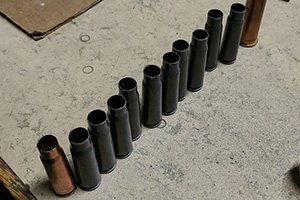 Military ammunition was made with corrosive primers for much longer, and there’s still a lot of surplus ammo on the market that uses them.
Military ammunition was made with corrosive primers for much longer, and there’s still a lot of surplus ammo on the market that uses them.
Before you reject ammo made with corrosive primers it’s worth asking why the military kept using them so long. Simple – they’re very reliable, and they’re particularly stable in long-term storage.
If you’re considering using very old ammo corrosive primers are actually a good thing, because the primers are probably still as reliable as the day they were made. As for the residue, if you clean your guns properly after firing this won’t be a problem.
Ammunition Storage
The most important thing about ammunition isn’t its age or what sort of primer it has; it’s how it was stored.
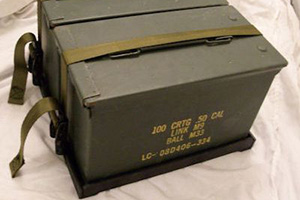
If ammo has been kept in a sealed box, protected from moisture and extreme temperature changes, it will last more or less indefinitely.
If it hasn’t been protected from moisture and temperature changes, of course, you might have some problems.
Related: How And Where To Store Ammo
Ammunition won’t be harmed by a quick dip in water, but if it’s kept in a damp place for a while it’s going to suffer – and every component is vulnerable. Primers, propellant, cases and even bullets will all degrade in a moist environment. And any one of them can cause a failure.
You can’t really tell the condition of propellant without breaking down a round, but visually checking the outside will tell you a lot about the state of the ammo. Corroded primers are likely to be defective or unstable, and those rounds should be discarded.
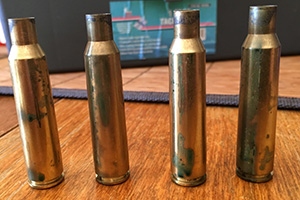 Light corrosion on brass cases isn’t always a problem, although you might get failures to feed or eject depending on how bad it is, but heavily corroded brass means you shouldn’t try firing that round.
Light corrosion on brass cases isn’t always a problem, although you might get failures to feed or eject depending on how bad it is, but heavily corroded brass means you shouldn’t try firing that round.
If there are any signs of splitting or cracking on the case, discard it.
It’s vital to check the actual bullet on old ammunition. If the bullet is loose, or pushed back into the case, get rid of that round. Loose bullets are likely to cause stoppages; deep-seated ones can raise chamber pressure and cause a dangerous breech explosion.
Watch out for heavily corroded bullets too – if the corrosion is bad enough they can stick in the barrel.
Related: How Much Ammo You Need For Practice Just To Keep Your Shooting Skills In Shape
Some people worry about squibs with old ammo – where a round doesn’t have enough power to push the bullet out the muzzle, and it stays stuck in the barrel. If that happens, the next round is likely to cause a breech explosion.
Squibs are very rare, though, and when they do happen it’s usually because of careless handloading. If an old round fires at all, it’s as likely to fire properly as a new one.
Firing Old Ammo
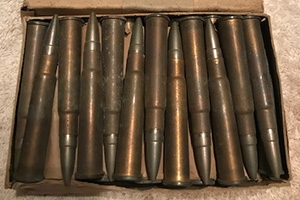
So in theory, old ammo should work fine as long as it’s been properly stored. How does that stack up to the reality?
I’ve fired .303 British ammunition that was well over 30 years old, and it worked perfectly.
The internet is full of videos of people using even older ammo. This rifleman is firing German 8mm made in 1942 – 79 years old, and as effective as ever.
Another shooter loaded his pistol with 96-year-old .45 ACP and every round fired. Even 88-year-old .22 long worked perfectly most of the time in an old revolver and a semi-auto rifle.
How about 50-year-old 12-gauge or 60-year-old 7.62mmx39? That’s no problem either. Got some 70-year-old Swedish 9mm? It’s probably as good as new.
If you don’t know how ammo has been stored there’s always a risk of misfires with older rounds, but if it looks to be in good condition it’s definitely worth trying. Even if one round in ten fails to fire – and that’s on the high side – it’s a lot better than having no ammo at all.
Rotate your ammunition supply and keep it as fresh as possible, but if old ammo is all you have left, use it and make it count.
You may also like:
 You Pass by This Plant Everyday Without Knowing How to Use It When SHTF
You Pass by This Plant Everyday Without Knowing How to Use It When SHTF
US Nuclear Target Map. Do You Live in The Danger Zone? (Video)
10+ Steps to Take Now for the Upcoming Economic Collapse

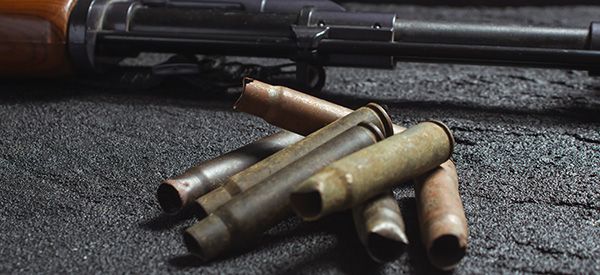













Keep it cook, keep it dry, Invest in Silica Gel.
55 years ago my father bought 1000 209 primers from an ammo reloading company. They were for federal shotgun shells. We were reloading Remington-Peters shotgun shells. Several years ago I received a CVS pro magnum 50 caliber muzzle loader for Christmas. It called for 209 primers and so have been using said primers for deer hunting ever since. No misfires whatsoever! They were stored in an dry, wooden gun cabinet with mostly constant temperature and humidity.
Please do not waste them on deers. We are fast becoming a totalitarian society. You will need them as laid out by the second amendment: to defend yourself from a tyrannical government. Thank you.
At my gun club we have service rifle matches. A large variety of rifles are used for these matches, M1, Mosins K98, SLME’s etc. All most all are firing vintage surplus ammo without problems.
I’ve got ammo from the early 90’s that’s still good,
I keep mine in ammo cans and in a controlled environment.
Factory ammo from the 1990s is almost brand new. I gave my brother some Lake City M-1 carbine ammo headstamped 1944 and he reported that it fired just fine and cycled the action like it was new.
The U.S. military switched to non-corrosive ammo approximately 1957-58. Lake City headstamped 1958 is most likely non-corrosive. It never hurts to field strip and clean your M-1 or 03-A3 immediately after firing anyway.
M-1 carbine ammo has been non-corrosive from the get-go. Still we are talking about steel that was forged before most of you were born. Clean it after you shoot it, corrosive or not.
If you are shooting ComBloc ammo I wouldn’t depend on the sales rep at Big 5 to correctly identify corrosive vs. non-corrosive. I would treat all ComBloc ammo as corrosive. Same goes for Russian ammo of all breeds and sizes. Yeah, yeah I know it says non-corrosive on the box. Do you believe it when Putin says he wants to be friends with the U.S.? Or that the Russian intrusion into the Ukraine is not an invasion? Nuff said.
If you shoot corrosive ammo, standard advice was that you had to scrub your bore with hot soapy water. That’s old hat. Urban rumor is that originally Hoppe’s #9 was designed to clean corrosive fouling from bores. Hoppe’s has been reformulated since 1933. I am not sure in its present formula it will actually clean fouling from corrosivecammo from your bore.
My practice is to use bore cleaner formulated for black powder fouling. While black powder fouling is not exactly corrosive primer fouling, most black powder bore cleaner is a water based cleaner rather than a solvent based bore cleaner. After cleaning the bore with black powder bore cleaner, I follow up with a current bore cleaner such as Ballistol or any number of the newer bore cleaners. I love the smell of Hoppe’s #9. It brings back memories of yesteryear and happy days. That said, there certainly is a place for bygone days and old friends no longer with us, but there are many newer, superior cleaners in the marketplace. Although I will always keep a bottle of Hoppe’s on my shelf just to enjoy the aroma and and the memories.
For lightly corroded cases and bullets there is dry steel wool and elbow grease. Polish the ammo with steel wool being sure to finish with a clean cloth. You don’t want to clean off brass tarnish to foul your chamber with steel wool residue.
While I have tumbled tarnished brass/bullets in corncob or walnut media in my brass tumbler, there is an urban legend that tumbling in a vibratory brass cleaner, I remember reading a statement by the owner of a large loading factory that all of their loaded rounds receive a final tumbling before being loaded in boxes. I will say that I have never had something untoward occur shooting tumbled after loading ammo.
I do try to limit the tumbling to the absolute minimum that I deem necessary. I don’t drop it in the tumbler to grind away until after supper the next day.
When shooting 50or 100 year old ammo, be extra alert for squib rounds. Don’t attempt unloading a full mag or clip as fast as you can. Firstly, if it is an M-1, the weapon is probably older than you by a couple of decades. The last M-1 rolls off the assembly line sometime around 1958. O3/A3s before the end of WWII. The Mosin-Nagant might be a battlefield pickup from the Battle for Moscow.
If you hear a shot that sounds anemic and the old gal didn’t kick with her usual vigor, stop shooting immediately, unload the piece and check the bore to see if you can see all the way from one end to the other. If you can’t, your bore is obstructed and you next shot without clearing that obstruction will be very interesting and will draw unwanted attention from the tang safety officer v
Hi LCC,
In some of my reloading books there is a warning about tumbling ammo after it is loaded. The issue is that powder is coated to control the burn rate and tumbling can rub off the coating thus the rate of burn/pressure can be increased to dangerous levels.
Also, as a M-1 shooter you know that the bullet weight and powder charge are matched to properly cycle the action. Tumbling loaded ammo could induce operational problems if not cause some more serious harm.
I think when dealing with pressure of 60,000 psi one should err on the side of caution.
Red Rover: I know that there are warnings about tumbling loaded ammo and what you posted is exactly the warning I mentioned.
I also agree that the loadings for the M-1 and most semi-automatic firearms must be loaded within a narrow spectrum of powder burn rate and a narrow spectrum of powder loaded viz a viz bullet weight.
With both of those admonitions in mind, however, I think of how ammunition is handled by the the service peons who are doing the muscle work of loading and unloading cases of ammo. I think of the long truck rides in the back of a PC or 6-by or jeep over unpaved roads or no roads with all the jouncing around.
With all that, I don’t think an hour in a tumbler full of medium will equal a ride from the port in Pakistan, over the Khyber Pass to Bagrum deep in Afghanistan. That’s just my personal opinion. I hope I am not wrong. I don’t do it much and I watch it carefully. As I said, I don’t tumble loaded ammo for extended periods of time. I might throw 100 empty cases of .30-06 in the tumbler and let them polish all night but I certainly wouldn’t do that with loaded ammo.
Your post is good advice and should be seriously considered by all. My post should be considered like folks who drive 100 mph on the highway. I’ve gotten away with it so far. The next round down the old M-1 may prove my undoing.
I went back and re-read my post. My modem died yesterday and as a first I typed my post on my cell phone. An interesting experience. The post is a little incoherent. My apologies to one and all.
“While I have tumbled tarnished brass/bullets in corncob or walnut media in my brass tumbler, there is an urban legend that tumbling in a vibratory brass cleaner. . .” There is a missing phrase here. It should read . . .”and reloading manuals warn against such practice . . .”
Again my apologies for my lapse.
No it does not expire. How you store it is how ammo is ruined or preserved
Storage is key, but there is another point to make… how was it handled ?
know a fella that used a H&H rifle for elk,
bought it and a case of factory ammo in the 60’s. He carried the same ammo for years(decades) when he hunted. those boxes of ammo rattled in his jeep all season long, year after year, He thought it was old age when the rifle kicked harder every year….. might have been the powder grains getting broken down into finer powder ?
Big thing to always look for, is crud or corrosion on the brass, especially the mouth area.
Good one to ask.
My self, I have ammo that I have had for more then 50 yrs and would shot it right know. we use to reload and would shot that if I had any from way back then. bought some 8MM from the 30’s or 40’s and a couple misfires but not many. I still have some of them.
Take care of your ammo and it will take care of you and your loved ones.
Don’t agree with getting rid of any ammo and surly not to the cops. come on man… really…
Remember we are preppers and we keep everything because it might be worth something some day.
All old ammo is dangerous to shoot. Just to be nice,
I’ll take it off your hands and properly dispose of it.
Spike: Thank you for your very kind offer. However, I like to live on the edge, so will continue to shoot my relatively new 1966 .303 British in my Short Magazine Lee Enfield.
After the end of the Russian follies in Afghanistan, there was a plethora of white box .303 British available at gun shows. It was at a good price and I failed to snatch it up while it was available. I am sure it wasn’t loaded with cordite but with whatever Winchester powder is suitable for such rounds.
I have to laugh at authors who talk about the odor of cordite in the air after a gun fight. They think it makes them sound all cool and a real gunny. It is a line from Winston Churchill’s book on the British campaign against the Madhi — I think that’s how they spelled the name of the sect. Churchill was engaged in the battle of Omdurman, shooting several Dervishes with his Mauser Broomhandle. In his book about the battle he spoke of the odor of cordite lingering in the air which was an accurate statement as the Lee Enfields at that time, 1898, were loaded with cordite.
Cordite was so named because instead of short pellets or round, flattened flakes, cordite was long strings of gunpowder that was loaded by hand into the cartridge cases. It was very slow loading which was one of the reasons use of cordite was abandoned with the advent of newer faster loading powders. If you are expending a million rounds of ammo a month or more, hand loading the rounds is a losing proposition.
The last time cordite loaded ammo was fired in rifles was probably in Afghanistan when the Russians first invaded there and the Afghanis dug out their Enfields and the ammo left there by the Brits when they pulled out of that benighted country.
Being the great warfighters they are, the Afghanis quickly realized that the AK74s and Dragunovs were superior to the old SMLE and quickly ditched their Enfields for more modern weaponry which the Russians so kindly lent them. At least that’s how the Russians describe how the Afghanis obtained newer Russian gear.
So if you read about the odor of cordite by some author after a gunfight with Glocks and Berettas or MP5s, know that author is plagiarizing Churchill. The author doesn’t have a clue what he is talking about. I have even read army officers talking about the odor of cordite after a gunfight in Vietnam. I know the Viet Cong may have used Enfields they had gotten from Malaysia or some other place but I guarantee they weren’t using .303 ammo loaded with cordite.
Current made ammo usually has a very short shelf life.
Lee the Geek
Which kind of ammo are you talking about. ???? How long dose it last then. ????
Lee: What is the basis for your statement? Please explain the reason for your post.
That statement is contrary to everything I have read about ammunition manufactured in the 21st century. Those statements are made by people who shoot a lot more than probably all the rest of us put together. I am talking about writers who regularly shoot 500 or more rounds in a day ringing out a new firearm. Professional ammo and gun manufacturer sponsored shooters who also shoot more than 500 rounds a day in practice and in matches. If those folks say that the ammo is better currently than it has ever been in the past, I personally would be reluctant to tell them they don’t know what they are talking about.
Yes, I understand that they might not publicly state that their sponsor’s ammo is junk but I also think they would not publicly say it was better than ever if they didn’t have some basis for it. They have their own individual reputations at stake when they make public statements.
Lee the geek, I agree. As soon as it gets on the shelf people are buying it up. Verrrry short shelf life.
Okay, you got us there. Indeed, modern ammo probably has a shelf life of 30 seconds from the time the clerk opens the box. However, once it is on your shelf in your gun room or closet or safe, it’s self life is considerably longer unless you are doing things that invite search warrants from all kinds of “law enforcement” minions.
Have to omit
, Stu. That was a good one. ?
My simple solution was to run about as much new ammo I might use in a range outing through my kitchen vacuum sealer bags. THEN I plop em into a fatboy GI Ammo can with a good rubber seal and label the front of the GI can as to what’s in it. No oxygen, no moisture = no oxidation. Like the old Russkie sardine cans.
THEN I use a 2U size rechargeable desiccant pouch in on top of it all. That one is about 1.5″ x 3.5″.
Rare, but you can get a slow leaking vacuum bag, so when you check your ammo yearly, if you found one the desiccant should have prevented any issues. Remove that pack of ammo and re-seal in a new bag.
The GI Can also buys you a little TIME to grab a fire extinguisher should you have a fire starting near your ammo in a cool dry basement. I have two smoke alarms in the small room with the ammo cans. That room is also below ground level.
You can get the rechargeable desiccant from Grainger Supply in a 5 gallon bucket, a lot of em, for $70 which is WAAAAAAY cheaper than anything on Amazon or the big gun distributors. My bucket was mfg just 5 weeks before I bought it, and the bucket is very well sealed. YO NEED the oven with the FAN inside it to dry out and recharge your desiccant overnight at like 225-250 degrees. Directions are right on the product.
NOT ALL desiccant is rechargeable so if you want that, be sure that’s what you are buying. Once you recharged your desiccant, AT LEAST get it into the GI Can or a zip lock! I go a little extra and that product that won’t be used right away, ALSO gets vac sealed in groups of 3 to keep it as dried out and fresh as your oven just got it.
Do this above and your ammo will be fine likely for longer than you will be able to shoot it. Maybe most of your kids life too.
If Biden has his way, the ammo you currently own may be the last you ever get unless you are wealthy.
My most brutal experience with old ammo would be some primed ready to load brass that was stored on the basement floor shelf next to an outside wall for maybe 30 years while I raised my kids and worked to hard to find time to reload. Though temps would have been consistent, humidity must not had been because some of the brass had blueish tarnish and even some pits in the brass. Primers exposed to the same conditions, Nothing to lose, I finished loading them with 30 year old Win 748 that had been opened 30 years prior. To my surprise, all went boom without so much as one FTF. I’ve loaded maybe a couple hundred of these already in the last couple years and no Fail to Fires. NO Bull. I’ve also used hundreds of old properly stored primers with no problems. I’ve also used hundreds of Russian rounds packed in Sardine Cans Mfg in the ’50s. Ammo is tougher than you can imagine. I don’t think you would have to do anything but stick it in an ammo can with a good seal, consistant temps and it should last a century or more as long as the ammo can isn’t compromised.
Ha! We had ours stored in the cabinet under the built in desk in the dining room. It didn’t survive 29 days in 12ft of flood water. We’re breaking down what we can, cleaning the cases and reloading what’s salvageable.
Been working at it slowly over the past 2 years since the flooding.
What’s awesome: Hornaday replaced the entire reloading set up at no cost to us.
I have various gauge shotgun shells kept in their original boxes in my unheated garage (in MI) for over 30 years. No protection except kept dry. Haven’t had a bad one yet.
tHE FILTHY dEMORATIC COMMUNISTS ARE COMING AFTER YOUR GUNS and AMMO !
The communist Dems are coming after our guns and ammo !
when I started hunting as a kid I was digging out my old man’s left over stuff from when he was a young guy – 40/50 years old at that time >>> some of it was the old roll crimp – all of it was paper hull -and none of it was stored with any care and preventions ….
Tumbling Loaded Ammo. | The High Road
Search domain http://www.thehighroad.org/index.php?threads/tumbling-loaded-ammo.864464/https://www.thehighroad.org/index.php?threads/tumbling-loaded-ammo.864464/
A couple of decades ago, after reading internet-based claims about tumbling ammo removing the graphite coating from propellant kernels and causing KABOOMS, I ran some tests (including velocity tests with a Chrony) and inspections for myself o
Although someone may have gotten to the post in your link, when I pressed the link on my tablet it took me to an error page. Upon close inspection of the link, I saw it was the same webpage posted twice in one string. I deleted half the long string in my browser and opened up an excellent forum page I’ve never seen before. I can tell I’m going to spend some time there.
I would imagine there are others who run into this same error and didn’t catch on as to why. They are really missing out on some good reading. If I may, I’d suggest fixing the double-long link in your post. If it doesn’t get fixed, perhaps they’ll see my reply and become aware of the issue.
Keep it hidden…….keep it safe.
– Gandalf
On the other hand, a relative of mine has some old shotgun ammo. We were hunting pheasants in the San Joaquin Valley. A nice cock flushed and my brother took the shot.
The shot had a weird sound sort of like a cough down a long piece of pic pipe.
I could see the shot column climbing up in the air after the pheasant, however the pheasant had gained more speed than the shot column and easily flew away as the shot column continued its arc and fell to the round. Examining the cartridge there was a dark ring in the plastic where the powder was located. He didn’t know how old the ammo was but opined it might have been originally purchased when he was a teenager some 60 years earlier.
Within the last ten years I have fired Sears brand 12 ga. shotshells with a dark ring around the base where the powder is with no untoward results.
If I were going on an expensive pheasant or other upland game hunt where I was paying big bucks for the privilege of hunting privately owned pheasant or chuckar,
I certainly wouldn’t use them but for breaking clay pigeons or just general fooling around shooting, they are fine.
Of course, the first thing to do after firing one of the strange sounding rounds and perhaps a companion shooter saying he saw the shot column heading up and out, would be to check to make sure nothing is stilll in the barrel.
Make sure you completely unload the gun before peering down barrel. Even a low speed, underpowered blast from a shotgun will certainly ruin your complexion at best and make a significant indentation in your head at worst.
This morning GunsandAmmo.com posted an e-mail that contained an article by Dave Emary who spent 24 years ad the head ballistic ian at Hornady AmmunitionCompany. The title of his article is The Effects of Heat on Powders. It is a technical article written by someone who should be far more expert than any of us on the topic.
I haven’t read it because it will take some time to read and digest. However, I would recommend the article to anyone interested in what Mr. Emary has to say about the topic
Corrosive Primers are no problem, All you have to do is pour boiling water through the Barrel and Receiver to clear the salts out because regular bore cleaners wont do it.Just be sure to dry and clean and oil the weapon before putting it away.I
I posted this warning on another link but I think it is important to post here too inasmuch as we are discussing ammo. This is from the Civilian Marksmanship Program.
The CMP is the Civilian Marksmanship Program whereby the U.S. government sells surplus firearms to members of gun clubs to maintain civilian marksmanship.
It was started after the War of Northern Aggression because of the abysmal marksmanship exhibited by Union troops during that dismal period in our history.
Dear CMP Family,
The CMP advises to not use .30/06 ammunition in M1 Garands, 1903s, and 1903A3s that is loaded beyond 50,000 CUP and has a bullet weight more than 172-174gr. These rifles are at least 70 years old and were not designed for max loads and super heavy bullets. Always wear hearing and eye protection when firing an M1 Garand, 1903 and/or 1903A3 rifle.
This warning is an update/addition to the Ammunition section in the Read This First manual enclosed with each rifle shipment (M1 Garand manual-page 6 and M1903 manual-page 10).
Be advised. Even an 03A3 cam’t take a hot load even though it is “newer” and is a bolt action.
There are low serial number 03s that should not be fired at all. If you have an 03 and are not sure if it is in the DO NOT FIRE group you can easily check the numbers involved on line. Yes, I know some advise as long as you are using light loads it is okay. It is until the bolt comes back and performs a field exodontic procedure on several teeth, rips up your tongue and breaks your jaw in the process.
Several years ago I shot a large Axis buck with an 8X57 Mauser. The ammo I used was from the 1940’s. One shot one kill at app 125 yards.
This was a very interesting thread … I was surprised that the corrosive primer discussion left out the trick that i was taught – can’t for the life of me remember where I read it – that I still use. I have a #4 Enfield, from the end of WW II, and re-arsenaled at Fazackerly. After I bought it – around 1990, I bought a slug of military ammo, made in South Africa in 1943. Some of it is machine gun ammo, and recoils a little stouter than the rest. I’m still using that ammo for practice. The technique that I was taught was to swab the bore immediately after finishing firing – not after coming home – with ammonia, which neutralizes the salts. Then I clean with Hoppes, and oil lightly. Ammonia leaves the bore extremely dry – oiling is a must. I did this at the range last week … the ammo still fires perfectly … and I guess the ammonia works ’cause my bore still looks great.